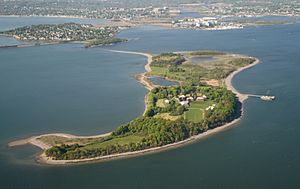David Thompson (New Hampshire settler) facts for kids

David Thompson (1588–1628) was an important person in early American history. He was the first governor of Massachusetts under a special land grant. He also received a large piece of land in what is now New Hampshire. Many people consider him the founder and first non-native settler of New Hampshire. An island in Boston Harbor is named Thompson Island after him.
Contents
David Thompson's Early Life
David Thompson was born in Corstorphine, a village in Scotland. His father, Richard Thomson, was a minister who worked for King James VI of Scotland.
David Thompson started studying philosophy at the University of Edinburgh in 1602. He married Amias Cole in England on July 13, 1613. Amias was the daughter of William Cole, a shipbuilder from Plymouth, England. They had three children: Ann, Priscilla, and John. Another son, Miles, might have been born on Thompson's Island in 1627.
Before returning to New England, David Thompson met Squanto in England. Squanto was a Native American who helped the Pilgrims. Thompson sailed with Squanto to New England in 1619. During this trip, Thompson helped rescue a Native American boy. The local leader gave the boy to Thompson as a servant.
Founding New Hampshire
The area that became New Hampshire started with a large land grant. This grant was given to David Thompson in 1622 by the Council for New England. After Thompson's death, Captain John Mason and Sir Ferdinando Gorges took over the land. Mason named the colony "New Hampshire" after the English county of Hampshire.
David Thompson first settled at Odiorne's Point in Rye in 1623. This was only three years after the Pilgrims arrived at Plymouth. Thompson came with a group of craftsmen and fishermen from England. They built a fort, a manor house, and other buildings for processing fish. They called their settlement "Pannaway Plantation."
In 1623, an English explorer named Christopher Levett visited Thompson at Pannaway Plantation. Some early historians thought the first European child born in New Hampshire was John Thompson. However, it was later found that John was baptized in England in 1619.
Moving to Boston and Disappearance
David Thompson's land grant was divided into two parts. Thompson received three-quarters of the land. The remaining quarter was held by three former mayors from Plymouth, England.
In 1626, Thompson moved his family to an island in Boston Harbor. This island is now called Thompson Island in his honor. He might have had a fur trading post there before moving. The Thompsons were among the first European settlers in Boston, Massachusetts.
David Thompson disappeared in 1628 and was never seen again. Some historians believe he was harmed by someone. Others think he accidentally drowned in Boston Harbor.
Thompson's wife, Amias (1596–1672), later married Samuel Maverick. Thompson's son, John, later managed to get ownership of Thompson Island. John Thompson was one of the first settlers in Mendon, Massachusetts. His brother, Miles, settled in Berwick, Maine.
See also
- List of people who disappeared
- New Hampshire Historical Marker No. 78: Odiorne's Point

